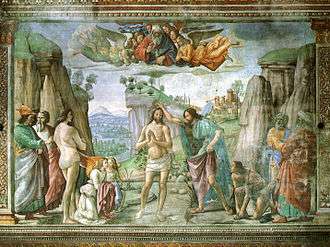The Agony and the Ecstasy (novel)
The Agony and the Ecstasy (1961) is a biographical novel of Michelangelo Buonarroti written by American author Irving Stone. Stone lived in Italy for years visiting many of the locations in Rome and Florence, worked in marble quarries, and apprenticed himself to a marble sculptor. A primary source for the novel is Michelangelo's correspondence, all 495 letters of which Stone had translated from Italian by Charles Speroni and published in 1962 as I, Michelangelo, Sculptor. Stone also collaborated with Canadian sculptor Stanley Lewis, who researched Michelangelo's carving technique and tools.[2] The Italian government lauded Stone with several honorary awards for his cultural achievements highlighting Italian history.
First edition | |
| Author | Irving Stone |
|---|---|
| Country | United States |
| Language | English |
| Genre | Biographical, Historical novel |
| Publisher | Doubleday |
Publication date | March 17, 1961[1] |
| ISBN | 0-451-21323-8 |
| OCLC | 56555113 |
Stone wrote some biographical novels, but this one and Lust for Life are best known, in large part because both had major Hollywood film adaptations.
Part of the 1961 novel was adapted to film in The Agony and the Ecstasy (1965), starring Charlton Heston as Michelangelo and Rex Harrison as Pope Julius II.
Works of Art Discussed in The Agony and the Ecstasy
Book One: The Studio
After Ghirlandaio looks at Michelangelo’s sketches of Christ drawn with a stonemason as the model, he tells Michelangelo the story of Donatello showing his newly carved crucifix to Brunelleschi. Brunelleschi observes that it seems to him Donatello has, “put a plowman on the cross, rather than the body of Jesus Christ, which was most delicate in all its parts." Donatello, upset by his friend’s criticism, challenges Brunelleschi to make Christ’s figure himself. When Brunelleschi presents his own, newly finished crucifix, “Donatello, who could not take his eyes off the beautiful Christ, answered, ‘It is your work to make Christs, and mine to make plowmen.’” Michelangelo, familiar with both carvings, tells Ghirlandaio that he “preferred Donatello’s plowman to Brunelleschi’s ethereal Christ, which was so slight that it looked as though it had been created to be crucified. With Donatello’s figure, the crucifixion had come as a horrifying surprise….”
Ghirlandaio was currently working on the sketches for the Baptism of Christ , which was to be one of the scenes in the fresco of the Tornabuoni Choir. Though Ghirlandaio never mentions their conversation about the figure of Christ again, Michelangelo sees his preferred Christ in Ghirlandaio’s finished figure: “The legs twisted in an angular position, a little knock-kneed; the chest, shoulders and arms those of a man who had carried logs and built houses; with a rounded, protruding stomach that had absorbed its quantity of food: in its power and reality far outdistancing any of the still-life set figures that Ghirlandaio had as yet painted for the Tornabuoni Choir.” (From Book Two, but about the same painting) Michelangelo “sketched his roughhewn young contandino just in from the fields, naked except for his brache, kneeling to take off his clodhoppers; the flesh tones a sunburned amber, the figure clumsy, with graceless bumpkin muscles; but the face transfused with light as the young lad gazed up at John. Behind him, he did two white-bearded assistants to John, with beauty in their faces and a rugged power in their figures. He experimented with flesh tones from his paint pots, enjoyed this culminating physical effort of bringing his figures to life, clothing them in warm-colored lemon-yellow and rose robes.”
In popular culture

- The book is mentioned in John Guare's Six Degrees of Separation as a book Paul, the protagonist, had recently completed.
- In the Mad Men season 2 episode "Flight 1", Peggy Olson's mother tells her daughters: "I have to renew The Agony and the Ecstasy; it's taking forever".
- In the autobiographical adventure book Minus 148°, author Art Davidson mentions that he is reading The Agony and the Ecstasy while waiting out a blizzard on the first winter ascent of Denali.
References
- "Books Today". The New York Times: 29. March 17, 1951.
- Bantey, Bill. "Montreal Artist Restores 10 Commandments to Stone". The Gazette. Montreal.
External links
- Irving Stone. I, Michelangelo, Sculptor. 1962. Michelangelo's letters. Translated by Dr. Charles Speroni, professor of Italian at the University of California, Los Angeles. Also includes a "list of characters."